The greatest quantity of artifacts is Jomon type pottery. There are thousands of potsherds including 1,884 rim sherds. These potsherds were found mainly in Layers B-F. Very few were found in Layers A and G and none in Layers H and I (Table 14).
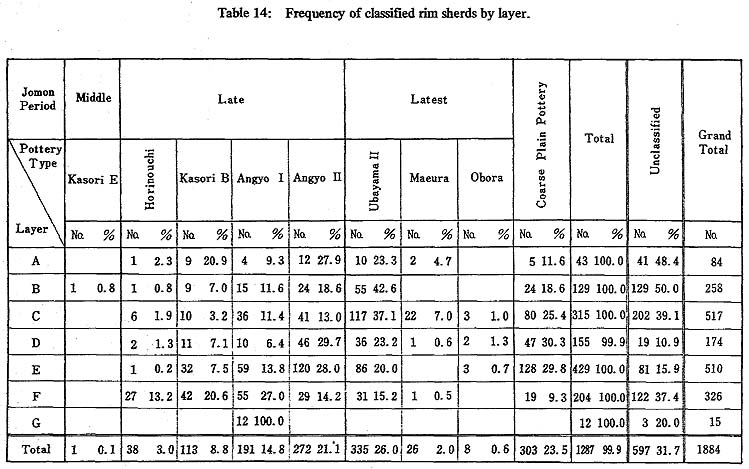
1. Classification
A total of 1,287 rim sherds was classified for this study. These belong to eight pottery types of the Middle, Late and Latest Jomon Periods (Table 14). The dominant pottery types are Kasori B, Angyo I and Angyo II of the Late Jomon Period, and Ubayama II of the Latest Jomon Period. Kasori E of Middle Jomon, Horinouchi of Late Jomon, and Maeura and Obora of Latest Jomon are not common.
The list below gives the vessel shapes constituting each of the eight pottery types as classified from the entire sherd collection.
- Middle Jomon Period:
- Kasori E Pottery Type
- Jar with flat rim
- Late Jomon Period:
- Horinouchi Pottery Type
- Jar with wavy rim
- Jar with flat rim (subtyped into A and B)
- Shallow bowl with flat rim
- Karori B Pottery Type
- Jar with flat rim (A, B, C, D)
- Shallow bowl with flat rlm (A, B)
- Angyo I Pottery Type
- Jar with wavy rim
- Jar with flat rim (A, B, C)
- Shallow bowl with flat rim
- Angyo II Pottery Type
- Jar with wavy rim (A, B, C)
- Jar with flat rim (A, B, C, D, E, F, G, H)
- Shallow bowl with flat rim (A, B, C)
- Spouted jar
- Latest Jomo Period:
- Ubayama II Pottery Type
- Jar with flat rim (A, B, C, D)
- Shallow bowl with wavy rim
- Shallow bowl with flat rim (A, B)
- Wide-mouthed globular jar
- Maeura Pottery Type
- Jar with flat rim (A, B)
- Shallow bowl with flat rim
- Pedestalled shallow bowl
- Obora Pottery Type
- Shallow bowl with flat rim
The sherds that did not conform strictly to the established pottery types fall into the two categories of coarse plain pottery and unclassifiable sherds. The first category has the same formal features as the pottery that Kondo thinks was used for boiling sea water to extract the salt (Kendo, 1962; Terakado et al, 1969; Tozawa et al, 1966). A total of 303 coarse plain rim sherds were collected from Layers A-F(23.5 percent of the total classified rim sherds). The sherds too small or eroded to permit accurate observation of their features are listed as unclassifiable (about 32 percent of the rim sherds).
Below are the distinguishing features of the eight pottery types and the coarse plain pottery classified and analyzed in this paper. The descriptions of the pottery types are based on the following method.
(1) First, the general description of each pottery type (including type site name, period and selected reference reports) is given.
(2) Second descriptions of vessel forms and decorations constituting each pottery type are given. The descriptions of vessel shapes are based on the entire collection of classified sherds, but the quantity given as sample size is the number of rim sherds.
1) Middle Jomon Period
(a) Kasori E Pottery Type
The Kasori E type is named after Locality E of the Kasori Shell-midden Site in Chiba Prefecture, excavated in 1924. This type belongs to the later half of the Middle Jomon Period in the Kanto Region (Yamanouchi, 1939)
Jar With Flat Rim (Fig. 16:1, Plate XXI:2)
- Size of sample:
- 1 rim sherd
- Vessel form reconstructed from sherds:
- Slightly elongated jar with flat rim. The rim is slightly convex and inturned, and the lip is slightly tapered and rounded. The body walls flare outward toward the rim.
- Techniques and basic pattern of decoration:
- Cord marks are impressed obliquely and irregularly on the exterior surfaces. Vertical and curved incised lines, 3-5 mm in width and 1-2 mm in depth, are on the rim and the body wall. The curved lines are roughly S-shaped or semicircular. The space inside semicircular or straight lines is scraped out and smoothly polished, and the space outside is covered with cord marking.

Figure 16: Rim sherds of Kasori E (1), Horinouchi (2-4) and Kasori B (5-12) Pottery Types (Scale 1/4).
1 (K-142); Jar with flat rim. From layer B (Plate XXI-2).
2 (K-143); Jar with flat rim. From layer F (Plate XXI-1).
3 (K-144); Jar with wavy rim. From layer F (Plate XXI-6).
4 (K-145); Jar with flat rim B. From layer F.
5 (K-146); Shallow bowl with flat rim B. From layer C (Plate XXI-7).
6 (K-147); Shallow bowl with flat rim B. From layer F (Plate XXI-8).
7 (K-148); Jar with flat rim C, From layer F (Plate XXI-5).
8 (K-149); Jar with flat rim D. From layer F.
9 (K-150); Jar with flat rim B. From layer F.
10 (K-151); Jar with flat rim B. Surface material (Plate XXI-3).
11 (K-152); Jar with flat rim B. From layer F (Plate XXI-4).
12 (K-153); Jai with flat rim B. From layer F. |
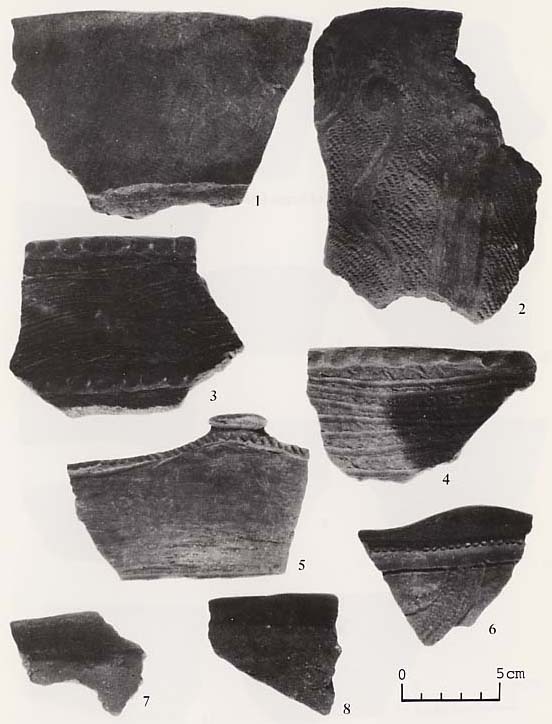
Plate XXI: Rim sherds of Kasori E (2), Horinouchi (1, 6), and Kasori B (3-5, 7, 8) Pottery Types (Scale1/2). |
2) Late Jomon Period
(a) Horinouchi Pottery Type
The Horinouchi type is named after the Horinouchi Shell-midden Site in Ichikawa City, Chiba Prefecture. This type represents the early half of the Late Jomon Period in the Kanto Region (Goto et al. 1958; Sugihara et al. 1964).
Jar With Wavy Rim (Fig. 16:3, Plate XXI:6)
- Size of sample:
- 2 rim sherds
- Vessel form reconstructed from sherds:
- Jar with slightly wavy rim. The rim is slightly thickened, and the lip is rounded.
- Techniques and basic pattern of decoration:
- Cord marks are impressed obliquely on the exterior. Horizontally straight and curved, sharp incisions, U-shaped in cross section, are on the rim. The space inside the semicircular lines is covered with cord marks, and the space outside is scraped out and polished. Clay ridges approximately 5 mm in width and 2 mm high, are attached to the rim, and circular dots, 1.5 mm in diameter, are impressed on this ridge.
Jar With Flat Rim
- This vessel shape has two variations: A(Fig. 16:2, Plate XXI: 1) and B (Fig. 16:4).
- Size of sample:
- 31 rim sherds (A:28,B:3)
- Vessel form reconstructed from sherds:
- A: Neckless jar with slightly flared, flat rim. The rim is not thickened, but the lip is tapered and rounded. B: Jar with flat rim. The rim is roughly vertical, and the lip is rounded.
- Techniques and basic pattem of decoration:
- A: Cord marks are impressed on the exterior surfaces. Shallow incisions, approximately 4 mm in width and 1.5 mm in depth, encircle the rim. B: Zoned hatchings and horizontally incised lines, 1-1.5 mm in width and depth, encircle the rim.
Shallow Bowl With Flat Rim
- Size of sample:
- 5 rim sherds
- Vessel form reconstructed from sherds:
- Shallow bowl with outward-flaring rim. The rim is thickened, and the Up is slightly eveled toward the outside.
- Techniques and basic pattern of decoration:
- The exterior surface is polished smoothly. Incised lines are on the interior. Highly projected, button-shaped ears are attached to the lip.
(b) Kasori B Pottery Type
The Kasori B type is named after Locality B of the Kasori Shell-midden Site in Chiba Prefecture, excavated in 1924. This type belongs to the middle half of the Late Jomon Period in the Kanto Region (Morse, 1879; Yamanouchi, 1939).
Jar With Flat Rim
- This vessel shape has four variations: A, B (Fig. 16:9-12, Plate XXI:3,4), C and D (Fig. 16:7, 8, Plate XXI: 5).
- Size of sample:
- 82 rim sherds (A:24, B:41, C: 13, D:4)
- Vessel form reconstructed from sherds:
- A: Neckless, wide-mouthed far with flat rim and rounded iip. The walls flare straightly.
- B: Wide-mouthed jar with flat rim. The rim is slightly concave and flares outward. C: Wide-mouthed jar with straight, flared rim. The lip is thickened and flat. The walls are relatively thin and approximately 5 to 6 mm in thickness. D: Same as C.
- Techniques and basic pattern of decoration:
- A: Cord marks are impressed on the exterior. Horizontally incised lines, 3 mm in width and 1.5 mm in depth, encircle the rim. No signs of polishing. B: Exterior surfaces are covered with coarse decorations made of wide but shallow cord marks and incised cross hatching, varying from large to fine hachure. A clay ridge, 7-0 mm in width and impressed with a finger tip, encircles the upper part of the rim and occasionally the lower part too. The interior surfaces are scraped out and slightly polished. C: No cord marks. The rim, the lower part of the body and the interior surfaces are generally finely polished and smoothed, the remaining areas are covered with cross hatching. D: Cord marks applied inside a space bordered by shallow incised lines with the space outside the lines scraped out and finely polished. Such zoned cord marks are generally applied to the upper part of the rim and the middle and lower parts of the body. That on the middle part of the body is a zigzag motif.
Shallow Bowl With Flat Rim
- This vessel shape has two variations: A (Fig. 16:3,4, Plate XXI:6) and B.
- Size of sample:
- 31 rim sherds (A:23,B:8)
- Vessel form reconstructed from sherds:
- A; Shallow bowl with angular shoulder and slightly constricted mouth. The angle of the shoulder is either sharp or rounded. The wall is of even thickness. The rim slants in a gentle curve on the interior. B: Shallow bowl with collard rim. The lip is slightly tapered and rounded.
- Techniques and basic pattern of decoration:
- A: The rim and interior surfaces are roughly polished and smoothed. B: Same as A.
(c) Angyo I Pottery Type
The Angyo type is named after the Angyo Shell-midden Site in Kawaguchi City, Saitama Prefecture, excavated in 1919. This type was divided into five subtypes - Angyo I, II, IIIa IIIb, IIIc - by Yamanouchi (1934). The first two belong to the Late Jomon Period in the Kanto Region (Kono, 1928; Yamanouchi, 1934; Omachi et al, 1937) and the latter three to the Latest Jomon Period.
Jar With Wavy Rim (Fig. 17:1-6, Plate XXII: 2-4)
- Size of sample:
- 13 rim sherds.
- Vessel form reconstructed from sherds:
- Slightly elongated jar with four large flanges on a strongly flaring rim. The neck is slightly constricted. The rim is thickened and the lip beveled toward the interior. A hole, 10-15 mm in diameter, pierces each rim flange.
.
- Techniques and basic pattern of decoration:
- Four bands of zoned cord marks encircle the rim. The middle part of the body is encircled by wave-form zoned cord marks, and the lowest part of the body is covered with oblique cord marks. The space outside the cord marks is generally deeply scraped out and smoothly polished. Small knob-shaped ears are attached to the run area.

Figure 17: Rim sherds of Angyo I Pottery Type (Scale 1/4).
1 (K-154); Jar with wavy rim. From layer G (Plate XXII-3).
2 (K-155); Jar with wavy rim. From layer F (Plate XXII-2).
3 (K-156); Jar with wavy rim. From layer E.
4 (K-157); Jar with wavy rim. From layer E.
5 (K-158); Jar with wavy rim. From layer G.
6 (K-159); Jar with wavy rim. From layer E (Plate XXII-4).
7 (K-160); Jar with flat rim A. From layer E. (Plate XXII-7).
8 (K-161); Jar with flat rim A. From layer E.
9 (K-162); Jar with flat rim A. From layer E.
10 (K-163); Jar with flat rim A. From layer F (Plate XXII-12).
11 (K-164); Jar with flat rim A. From layer F.
12 (K-165); Jar with flat rim A. From layer F (Plate XXII-1).
13 (K-166); Jar with flat rim B. From layer E.
14 (K-167); Jar with flat rim B. From layer E.
15 (K-168); Jar with flat rim B. From layer E.
16 (K-169); Jar with flat rim B. Surface material.
17 (K-170); Jar with flat rim B. From layer F (Plate XXII-11).
18 (K-171); Jar with flat rim B. From layer E (Plate XXII-6).
19 (K-172); Jar with flat rim C. From layer E (Plate XXII-10).
20 (K-173); Jar with flat rim C. From layer F.
21 (K-174); Jar with flat rim C. From layer F.
22 (K-175); Shallow bowl with flat rim. From layer E (Plate XXII-8).
23 (K-176); Shallow bowl with flat rim. From layer E (Plate XXII-5).
24 (K-177); Shallow bowl with flat rim. From layer F (Plate XXII-9).
25 (K-178); Shallow bowl with flat rim. From layer F.
26 (K-179); Shallow bowl with flat rim. From layer E.
27 (K-180); Shallow bowl with flat rim. From layer E.
28 (K-181); Shallow bowl with flat rim. From layer E. |
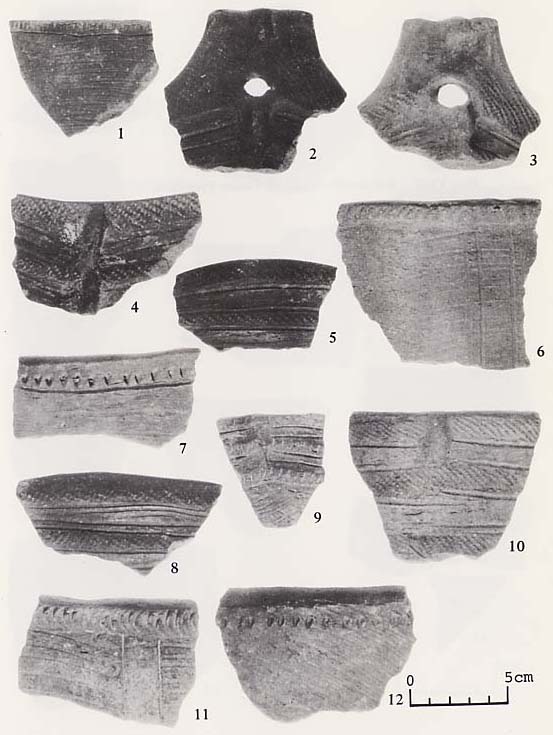
Plate XXII: Rim sherds of Angyo I Pottery Type (Scale 1/2). |
Jar With Flat Rim
- This vessel shape has three variations: A (Fig. 17:7-12, Plate XII: 1,7,12), B (Figs. 17:13-18, 21:1, Plates XXII:6, 11)and C (Fig. 17:19-21, Plate XXII: 10).
- Size of sample:
- 170 rim sherds (A:41, B:49, C;80).
- Vessel form reconstructed from sherds:
- A: Bullet-shaped jar with slightly thickened rim; the lip is generally rounded, and the rim is straightly vertical. B: Bullet-shaped jar with thickened rim; the lip is either rounded or flattened, and the rim is straightly vertical. C: Roughly bullet-shaped jar with thickened rim, with the lip beveled toward the interior. The walls are thinner than those of A and B (approximately 5 mm in thickness).
- Techniques and basic pattern of decoration:
- A: Large to fine hachures cover the exterior surfaces. Triangular or semicircular dots encircle the rim. On some examples, horizontally incised lines, shallow or V-shaped, encircle the rim below the dotted band. B: Almost the same as A but a clay ridge, impressed with the finger-tip instead of dotted line, encircles the rim and the neck. C: Oblique cord marks are impressed in zones bordered by straight or semicircular, fine, shallow incisions. The spaces between the zoned cord marks are polished smoothly. Two rows of these polished zones encircle the rim. The lower part of the body is covered with oblique cord marks. Small, knob-shaped ears are attached to the rim.

Figure 21: Vessel shapes of Angyo I (1) and Angyo II (2) Pottery Types (Scale 1/4).
1 (K-126); Jar with flat rim B of Angyo I type (fragment). From layer E.
2 (K-127); Jar with wavy rim C of Angyo II type (fragment). From layer E. |
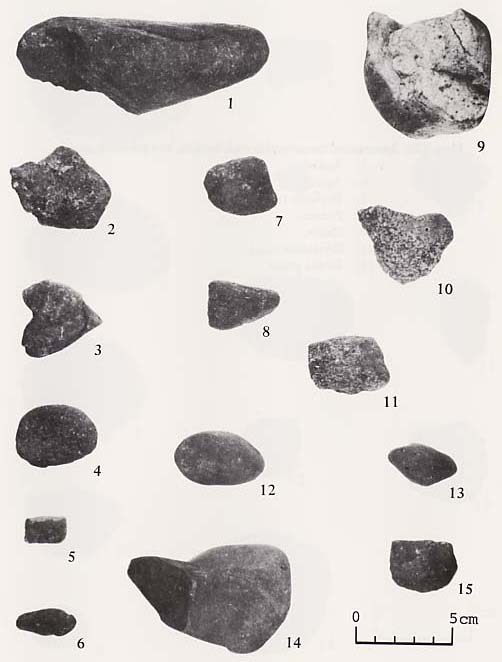
Plate XII: Plutonic rock samples (Scale 1/2).
1-8; Quartz porphyry,
9; Granite,
10; Diorite,
11-15; Gabbro |
Shallow Bowl With Flat Rim (Fig. 17:22-28, Plate XXII:5,8,9)
- Size of sample:
- 8 rim sherds
- Vessel form reconstructed from sherds:
- Wide-mouthed shallow bowl with flat bottom. The lip is roughly flat.
- Techniques and basic pattern of decoration:
Three bands of zoned cord.marks encircle the rim and body. The space between the zones is scraped out and smoothly polished. In some examples, horizontal incisions are made in the polished space between the zoned cord marks.
(d) Angyo II Pottery Type
The Angyo II type belongs to the latest part of the Late Jomon Period in the Kanto Region (Kono, 1928;Yamanouchi, 1934;Suzuki, 1965).
Jar With Wavy Rim
- This vessel shape has three variations: A (Fig; 18:1-3, Plate XXIII:2, 3), B (Fig. 18:4-6, Plate XXIII: 1) and C (Fig. 21:2).
- Size of sample:
- 31 rim sherds (A:9,B:21,C:1).
- Vessel form reconstructed from sherds:
- The three variations in shapes are nearly identical; large wide-mouthed jars with four large waves on a cylindrical rim, a rounded shoulder, and a conical body. The rim is almost vertical and thickens towards the lip. The body wall is relatively thick (approximately 5 mm).
- Techniques and basic pattern of decoration:
- The three forms have fundamentally common techniques and patterns of decoration. On the rim and shoulder are zoned cord marks and polished spaces arranged alternately. The lower part of the body is generally covered with oblique cord marks. The zoned cord marks are bordered by shallow incised lines, 1-3 mm in width. The spaces between the zones are rectangular, oblong and triangular, and are scraped out and smoothly polished. Various kinds of decorative bosses: flat, oval button-shaped ones (Fig. 21:2), 0-shaped ones (Fig. 18:1-3, Plate XXIII:2, 3), and tongue-shaped ones (Fig. 18:4-6, Plate XXIII:l) are arranged systematically on the exterior surface, especially on the zoned cord marks and the waves of the rim. The three vessel forms differ slightly from each other in the shapes of their bosses and zoned cord marks.

Figure 18: Rim sherds of Angyo II Pottery Type (Scale 1/4).
1 (K-182); Jar with wavy rim A. From layer E (Plate XXIII-2).
2 (K-183); Jar with wavy rim A. From layer E.
3 (K-184); Jar with wavy rim A. From layer E (Plate XXIII-3).
4 (K-185); Jar with wavy rim B. From layer E (Plate XXIII-1).
5 (K-186); Jar with wavy rim B. From layer F.
6 (K-187); Jar with wavy rim B. From layer D.
7 (K-188); Jar with flat rim H. From layer D (Plate XXIII-4).
8 (K-189); Jar with flat rim A. From layer E.
9 (K-190); Jar with flat rim A. From layer E (Plate XXIII-11).
10 (K-191); Jar with flat rim A. From layer E.
11 (K-192); Jar with flat rim A. From layer E (Plate XXIII-9).
12 (K-193); Jar with flat rim B. From layer C.
13 (K-194); Jar with flat rim B. Surface material (Plate XXIII-8).
14 (K-195); Jar with flat rim B. From layer E.
15 (K-196); Jar with flat rim B. From layer C.
16 (K-197); Jar with flat rim B. From layer E.
17 (K-198); Jar with flat rim C. From layer C.
18 (K-199); Jar with flat rim C. From layer C.
19 (K-200); Jar with flat rim D. From layer E (Plate XXIII-12).
20 (K-201); Jar with flat rim D. From layer E.
21 (K-202); Jar with flat rim D. From layer E.
22 (K-203); Jar with flat rim E. From layer C (Plate XXIII-5).
23 (K-204); Jar with flat rim E. From layer E.
24 (K-205); Jar with flat rim F. Surface material.
25 (K-206); Jar with flat rim F. From layer D.
26 (K-207); Jar with flat rim G. Surface material.
27 (K-208); Jar with flat rim G. From layer C.
28 (K-209); Jar with flat rim G. From layer E (Plate XXIII-6).
29 (K-210); Shallow bowl with flat rim C. From layer E.
30 (K.211); Shallow bowl with flat rim A. From layer D (Plate XXIII-10).
31 (K-212); Shallow bowl with flat rim A. From layer D.
32 (K-213); Shallow bowl with flat rim A. From layer E (Plate XXIII-7).
33 (K-290); Shallow bowl with flat rim C. From layer E (Plate XXIII-13).
34 (K-291); Shallow bowl with flat rim C. From layer E. |
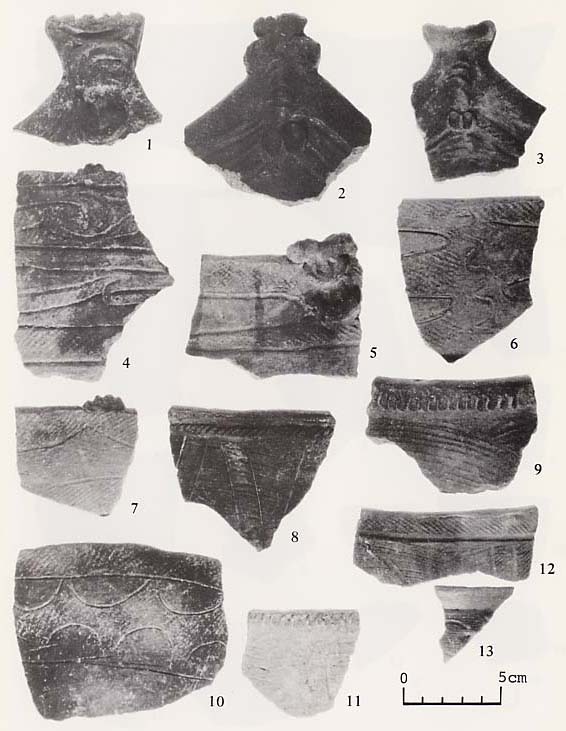
Plate XXIII: Rim sherds of Angyo II Pottery Type (Scale 1/2). |
Jar With Flat Rim
- This vessel has eight variations: A (Fig. 18:8-11, .Plate XXIII: 9,11), B (Fig. 18:12-16, Plate XXIII:8), C (Fig. 18:17, 18), D (Fig. 18:19-21, Plate XXIII:12), E (Figs. 18:22, 23, 24:1, Plates XXIII:5, XXVII: 1), F (Fig. 18:24, 25), G (Fig. 18:26-28, Plate XXIII: 6) and H (Figs. 22:2, 23:1, 2, Plate XXVI: 1).
- Size of sample:
- 211 rim sherds (A: 18, B:68, C: 10, D: 15, E:82, F:4, G: 12, H:2).
- Vessel form reconstructed from sherds:
- All vessels show nearly the same morphological features: roughly bullet-shaped jars with slightly inturned rims, The rim is generally thickened and the lip rounded.
- Techniques and basic pattern of decoration:
A: Two bands of clay ridges, impressed with a finger-tip and 7-15 mm in width and 2-4 mm in height, encircle the rim. The space between the clay ridges and the entire body are covered with large or fine hachures; the outside space is polished smoothly. The hachured space between the clay ridges is bordered by shallow curved incisions, 2 mm in width. B: The vertically and obliquely zoned spaces on the rim, bordered by straight incisions, are polished smoothly; the outside space is covered with hachures. B: Almost the same as A. C: Semicircular or spiral-shaped spaces on the rim are bordered by curved and straight lines and are polished smoothly. The remaining spaces are covered with hachures. D: Almost the same as the first three, but cord marks instead of clay ridges are impressed on the rim. E: Cord marks are impressed on the rim. Some spaces on the rim are bordered by straight or curved incised lines and are smoothly polished. O-shaped and button-shaped bosses are attached to the rim. The lower part of the body is covered with hachures. F: Two bands of zoned cord marks and sometimes also one band of small dots encircle the rim. On the rim also are semicircular spaces bordered by shallow, curved incisions and covered with cord marks. The spaces outside these semicircular ones are polished smoothly. G: Spaces between straight or zigzag lines are smoothly polished. Incised horizontal lines and vertical S-shaped lines encircle the rim. H: Straight and curved incised lines are on the rims. The spaces bordered by these lines are either covered with cord marks or smoothly polished.

Figure 22: Vessel shapes of Angyo II Pottery Type (Scale 1/4).
1 (K-128); Jar with flat rim B of Angyo II type (fragment) From layer D (Plate (XXVII-2).
2 (K-129); Jar with flat rim H of Angyo II type (fragment). Surface material (Plate XXVI-1). |

Figure 23: Vessel shapes of Angyo II Pottery Type (Scale 1/4).
1 (K-130); Jar with flat rim H of Angyo II type (fragment). From layer E.
2 (K-131); Jar with flat rim H of Angyo II type (fragment). Surface material. |

Figure 24: Vessel shapes of Angyo II Pottery Type (Scale 1/4).
1 (K-132); Jar with flat rim E of Angyo II type (fragment). From layer D (Plate XXVII
2 (K-133); Jar with flat rim B of Angyo II type (fragment). From layer E. |
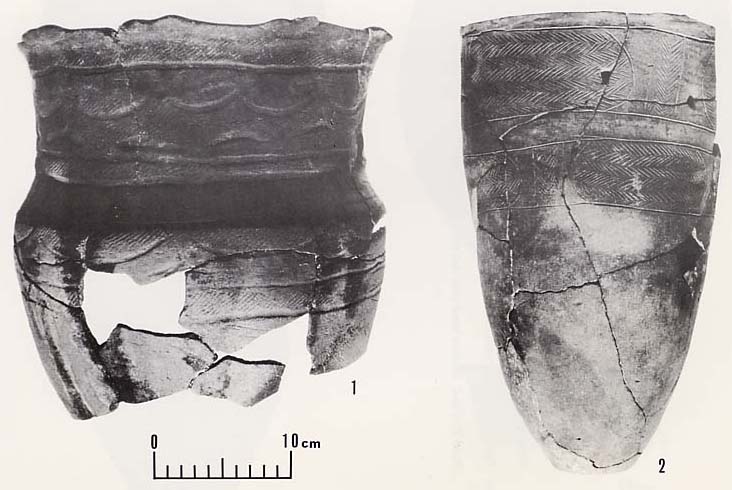
Plate XXVI-1: Jar with flat rim H of Angyo II Pottery Type.
Plate XXVI-2: Jar with flat rim D of Ubayama II pottery Type. |
Shallow Bowl With Flat Rim
- This vessel shape has three variatlons: A (Fig. 18:30-32, Plate XXIII:7, 10), B and C (Fig. 18:29, 33, 34, Plate XXIII: 13).
- Size of sample:
- 28 rim sherds (A;1,B;2,C;25)
- Vessel form reconstructed from sherds:
- A: Shallow bowl with gently outward-sloping sides and rounded bottom. The rim is generally thickened. B: Shallow bowl with angular shoulder and slightly constricted mouth. The angle of the shoulder is either sharp or rounded. C: Flared, wide-mouthed bowl with slightly constricted neck. The body is rounded and the lip is square-edged with no significant thickening.
- Techniques and basic pattern of decoration:
- A: A band of zoned cord marks encircles the rim, and below this band a row of smoothly polished semicircular spaces encircles the body. Incised lines are 1-1.5 mm in width and 0.5-1 mm in depth. There are O-shaped bosses on the lip. B: Broad but shallow incised lines, 3-4 mm in width and 1-2 mm in depth, are on the exterior, and small, knob-shaped ears are attached to the shoulder. C: A band of zoned cord marks approximately 10 mm in width encircles the rim and the middle of the body. Sharp V-shaped incisions, 1-3 mm in width and 1.5 mm in depth, are on the exterior. The spaces not marked with cord are smoothly polished.
Spouted Jar
- Size of sample:
- 2 sherds
- Vessel form reconstructed from sherds:
- Spouted jar with slightly convexed body and thickened rim. The lip is beveled toward the interior.
- Techniques and basic pattern of decoration:
- Almost the same as Angyo II type jar with wavy rim.
3) Latest Jomon Period
(a) Ubayama II Pottery Type
The Ubayama II type is named after the Ubayama Site in Sambu, Yokoshiba City, Chiba Prefecture. This type belongs to the early half of the Latest Jomon Period (Suzuki, 1963, 1964, 1965).
Jar With Flat Rim
- This vessel shape has four variations: A (Figs. 19:1-4, 25:1, Plate XXIV:1, 3), B (Fig. 19:5-7, Plate XXIV:11), C (Fig. 19:8, 9) and D (Figs. 19:10, 11, 25:3, Plates XXIV:8, XXVI:3).
- Size of sample:
- 296 rim sherds (A:235, B:34, C:8, D:19)
- Vessel form reconstructed from sherds:
- A and B: Roughly bullet-shaped jar. The thickened rim slants slightly inward. The lip is rounded or slightly beveled toward the exterior. The wall thickness is relatively thin (5-7 mm in thickness). C: Roughly bullet-shaped jar with slightly thickened rim. The body wall is slightly convex. The lip is rounded. D: Bullet-shaped jar. The lip is beveled toward the interior. The sides are almost vertical. The body walls are thin (4-5 mm in thickness).
- Techniques and basic pattern of decoration:
- A: Shallow hachures run roughly horizontally or obliquely on the exterior surface of the rim and roughly vertically on the body. On some examples a vertical zigzag motif is produced on the rim by V-shaped incised lines, 2 mm in width. B: The rim is smoothly polished. Hachures run horizontally on the upper part and vertically on the lower part of the body. C: Two rows of rectangular spaces bordered by the incised lines, scraped out and nicely polished, encircle the rim. The space between these is covered with cord marks. On the body are oblique hachures. D: Rectangular or semicircular spaces on the rim are bordered by incised lines and are covered with fine incisions.

Figure 19: Rim sherds of Ubayama II (1-19), Maeura (20-29) and Obora (30-34) Pottery Type (Scale 1/4)
1 (K-214); Jar with flat rim A. From layer F (Plate XXIV-1).
2 (K-215); Jar with flat rim A. From layer E.
3 (K-216); Jar with flat rim A. Surface material (Plate XXIV-3).
4 (K-217); Jar with flat rim A. From layer E.
5 (K-218); Jar with flat rim B. From layer E.
6 (K-219);Jar with flat rim B. From layer E (Plate XXIV-11).
7 (K-220); Jar with flat rim B. From layer E.
8 (K-221); Jar with flat rim C. From layer C.
9 (K-222); Jar with flat rim C. From layer E.
10 (K-223); Jar with flat rim D. From layer C.
11 (K-224); Jar with flat rim D. From layer F (Plate XXIV-8).
12 (K-225); Shallow bowl with wavy rim. From layer B.
13 (K-226); Shallow bowl with wavy rim. From layer F.
14 (K-227); Shallow bowl with flat rim A. From layer C (Plate XXIV-12).
15 (K-292); Shallow bowl with flat rim A. From layer C.
16 (K-228); Shallow bowl with flat rim B. From layer C.
17 (K-229); Shallow bowl with flat rim B. From layer D.
18 (K-230); Wide-mouthed globular jar. From layer D (Plate XXIV-2).
19 (K-231); Wide-mouthed globular jar. From layer F.
20 (K-232); Jar with flat rim A. From layer C (Plate XXIV-5).
21 (K-233);Jar with flat rim A. From layer C (Plate XXIV-6).
22 (K-234); Jar with flat rim B. From layer C (Plate XXIV-4).
23 (K-235); Jar with flat rim B. From layer C (Plate XXIV-7).
24 (K-236); Jar with flat rim B. From layer C.
25 (K-237); Shallow bowl with flat rim. From layer C.
26 (K-238); Jar with flat rim B. From layer C.
27 (K-239); Jar with flat rim B. From layer C.
28 (K-240); Shallow bowl with flat rim. From layer D.
29 (K-241); Pedestralled shallow bowl. From layer C.
30 (K-242); Shallow bowl with flat rim of Obora B-C type. from layer C (Plata XXIV-10).
31 (K-243); Shallow bowl with flat rim of Obora C type. From layer C (Plate XXIV-9).
32 (K-244); Shallow bowl with flat rim of Obora C type. From layer C (Plate XXIV-13).
33 (K-245); Shallow bowl with flat rim of Obora C type. From layer C (Plate XXIV-14).
34 (K-246); Spouted vessel of Obora C type. From layer C. |
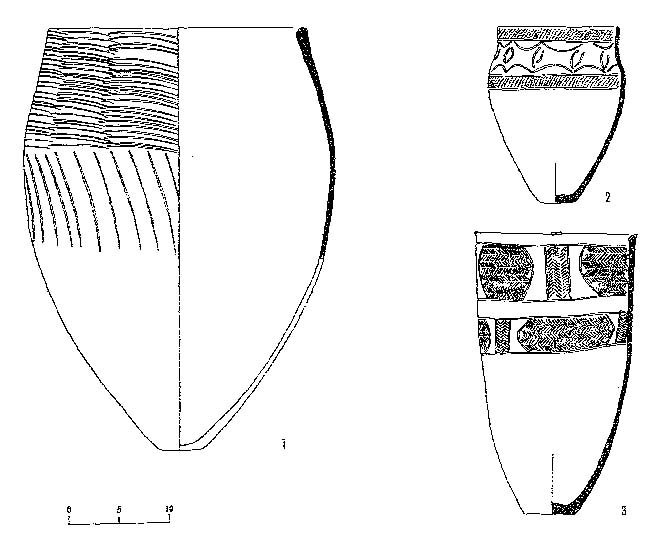
Figure 25: Vessel shapes of Ubayama II Pottery Type (Scale 1/4).
1 (K-134); Jar with flat rim A of Ubayama II type (fragment). From layer D.
2 (K-135); Jar with flat rim C of Ubayama II type. From layer D (Plate XXVII-3).
3 (K-136); Jar with flat rim D of Ubayama II type. From layer D (Plate XXVI-3). |

Plate XXIV: Rim sherds of Ubayama II (1-3, 8,11,12), Maeura (4-7) and Obora (9,10,13,14) Pottery Type (Scale 1/2). |
Shallow Bowl With Wavy Rim (Fig. 19:12, 13)
- Size of sample:
- 3 rim sherds
- Vessel form reconstructed from sherds:
- Shallow bowl with outward-flaring, waved rim. The rim is thinned and the lip pointed. The walls are an even thickness, approximately 2-3 mm. The base is rounded.
- Techniques and basic pattern of decoration:
- Zoned cord marks encircle the rim and the lower part of the body. The zoned cord marks on the rim are in semicircular spaces bordered by incised lines. The spaces outside these are polished.
Shallow Bowl With Flat Rim
- This vessel shape has two variations: A (Figs. 19:14,15. 26:1, Plates XXIV:12, XXVII:4) and B (Figs. 19:16, 17, 26:3, 4).
- Size of sample:
- 30 rim sherds (A: 14, B: 16)
- Vessel form reconstructed from sherds:
- A: Constricted neck, shallow bowl with outward-flaring rim and rounded base. The rim is not thickened, but the lip is slightly tapered and rounded. The walls are rounded and of even thickness, 6-7 mm. B: Shallow bowl with gently outward-sloping sides and flat bottom. The rim is an even 6 mm thick, and the lip is slightly beveled toward the exterior.
- Techniques and basic pattern of decoration:
- A: Zoned cord marks encircle the rirn and the middle part of the body. The space between the two bands of zoned cord marks is polished. The interior surfaces are slightly polished. B: Plain pottery. The exterior is coarsely scraped out. Ribbon-shaped projections are generally attached to the lip.
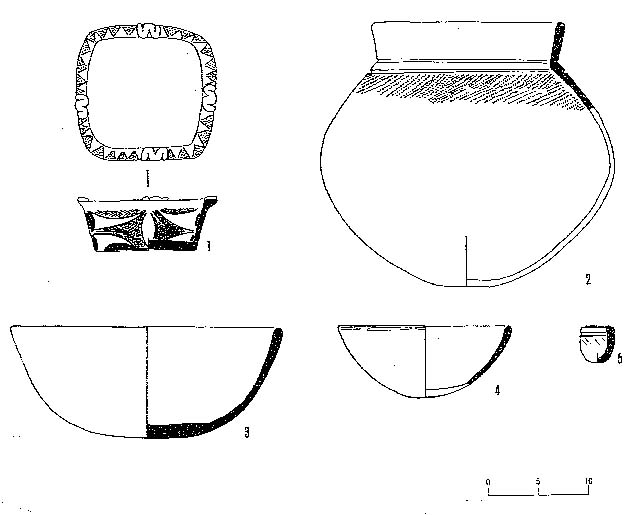
Figure 26: Vessel shapes of Ubayama II Pottery Type (1-4) and unclassified specimen (5) (Scale 1/4).
1 (K-137); Shallow bowl with flat rim A of Ubayama II type. From layer D (Plate XXVII-4).
2 (K-138); Wide-mouthed globular jar of Ubayama II type (fragment). From layer D.
3 (K-139); Shallow bowl with flat rim B of Ubayama II type. From layer D.
4 (K-140); Shallow bowl with flat rim B of Ubayama IItype (fragment). From layer D.
5 (K-141); Unclassified miniature vessel. From layer F. |
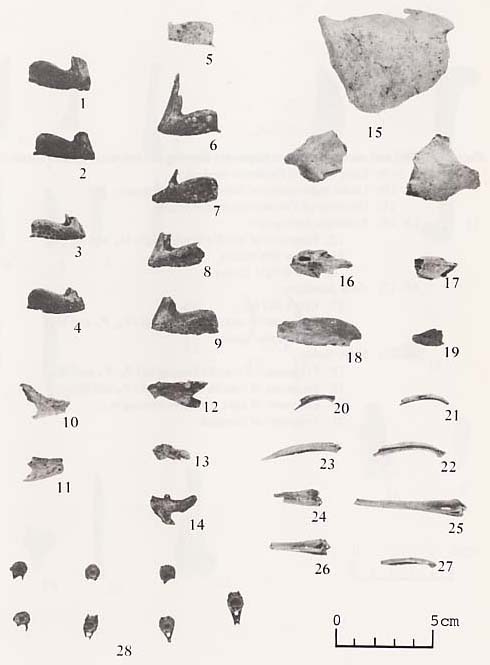
Plate VII: Fish bone fragments showing the following species (Scale 1/2).
1-14; Acanthopagrus schlegeli:
1-4; left premaxilla,
5-9; right premaxilla,
10-11; left dentary,
12-14; right dentary
15; Left opercle of Mugil cephalus
16, 17; Lateolabrax japonicus:
16; left dentary,
17; right dentary
18, 19; Chrysophrys major:
18; left premaxilla,
19; right dentary
20-22; Left dentary of Platycephalus indicus,
23,27; Spines of Sparidae,
24-26; Interhaemal spines of Sparidae,
28; Vertebra of Sparidae |
Wide-Mouthed Globular Jar (Figs. 19:18,19, 26:2, Plate XXIV:2)
- Size of sample:
- 6 rim sherds
- Vessel form reconstructed from sherds:
- Wide-mouthed globular jar with short, constricted neck and rounded bottom. The rim flares outward. The walls are convex and of even thickness, 5-6 mm.
- Techniques and basic pattern of decoration:
- Horizontal bands of zoned cord marks, bordered by incised lines 3-4 mm in width. encircle the rim. The space below the constricted neck is also covered with cord marked areas bordered by incised lines. The spaces without cord marking are polished. Ribbon-shaped projections are attached to the lip.
(b) Maeura Pottery Type
The Maeura type is named after the Maeura Site in Ibaragi Prefecture. This type belongs to the middle part of the Latest Jomon Period in the Kanto Region (Sugihara et al: 1963, Suzuki, 1963, 1965).
Jar With Flat Rim
- This vessel shape has two variations: A (Fig. 19:20, 21, Plate XXIV: 5, 6) and B (Fig. 19:22-24, Plate XXIV:4, 7).
- Size of sample:
- 22 rim sherds (A:5,B:17)
- Vessel form reconstructed from sherds:
- A: Wide-mouthed jar with almost vertical rim and conical body. The rim is thickened and the lip rounded. B: Roughly globular jar with rounded shoulder and constricted neck. The rim is thinned and almost vertical. The lip is flattened or rounded.
- Techniques and basic pattern of decoration:
- A: Horizontal bands of zoned cord marks encircle the rim. The spaces outside these bands are polished. Broad lines, 7 mm in width, also encircle the rim just below the zoned cord marks. B: Two or three horizontal bands of zoned cord marks, bordered by broad incisions over 7 mm in width, encircle the rim and shoulder. All surfaces outside these bands, including the interior surface, are polished. One or two broad, shallow incisions, 5-8 mm in width, encircle the interior of the rim. Ribbon-shaped projections are attached to the lip.
Shallow Bowl With Flat Rim (Fig. 19:28)
- Size of sample:
- 3 rim sherds
- Vessel form reconstructed from sherds:
- Shallow bowl with gently outward-flaring rim. The rim is thickened and the lip beveled toward the interior.
- Techniques and basic pattern of decoration:
- Bands of zoned cord marks encircle the rim and lower part of the body. Ribbon-shaped projections are attached to the lip.
Pedestalled Shallow Bowl (Fig. 19:29)
- Size of sample:
- 1 sherd
- Vessel form reconstructed from sherds:
- Fragment too small for reconstruction.
(c) Obora Pottery Type
- The Obora type belongs to the Latest Jomon Period in the Tohoku Region. This type has been divided into six subtypes - Obora B, B-C,C1 C2. A and A' (Yamanouchi, 1930; Serizawa, 1960). Only types B-C and C1 were found at the Kamitakatsu Site.
- Size of sample:
- 3 (B-C) and 5 (C1) rim sherds
- Vessel form reconstructed from sherds:
- There are two forms - shallow bowls and spouted vessels. The B-C (Fig. 19:30, Plate XXIV:10) and C1 (Fig. 19:31-33, Plate XXIV:9, 13, 14) shallow bowls are nearly identical, but the wall of the body of the C1 type is thicker than that of B-C type. The spouted (Fig.19:34) vessel belongs to the C1 type. It has a short neck with a flared rim, and a lateral flange on the central part of the body.
- Techniques and basic pattern of decoration:
- The basic decoration techniques are incised lines and cord marks.
4) Corse plain pottery (Fig. 20:1-22, Plate XXV)
- Size of sample:
- 303 rim sherds
- Vessel form reconstructed from sherds:
- The majority of the vessels are wide-mouthed jars with outward-flaring walls. The rim is generally beveled foward the outside or flat, but some examples have finger-made, sharp or pointed lips. The walls flare straightly. Some examples resemble elongated, bullet-shaped jars. The body wall is of even thickness, 3-5 mm.
- The remaining vessels are shallow bowls. The walls generally flare straightly, and the base is small and flat (Fig. 20:40-43). Some examples have mat or leaf imprints on their base (Fig. 20:40-42).
- Techinques and basic pattern of decoration:
- The exterior surfaces are coarse and plain.

Figure 20: Rim sherds of coarse plain pottery (1-22) and pottery bases (23-43) (Scale 1/4).
1 (K-247); Coarse plain pottery. From layer E (Plate XXV-7).
2 (K-248); Coarse plain pottery. From layer E (Plate XXV-1).
3 (K-249); Coarse plain pottery. From layer E.
4 (K-250); Coarse plain pottery. From layer E.
5 (K-251); Coarse plain pottery. From layer E.
6 (K-252), Coarse plain pottery. From layer E.
7 (K-253); Coarse plain pottery. From layer E (Plate XXV-12).
8 (K-254); Coarse plain pottery. From layer E (Plate XXV-2).
9 (K-255); Coarse plain pottery. From layer E (Plate XXV-10).
10 (K-256); Coarse plain pottery. From layer E (Plate XXV-4).
11 (K-257); Coarse plain pottery. From layer E (Plate XXV-3).
12 (K-258); Coarse plain pottery. From layer E (Plate XXV-8).
13 (K-259); Coarse plain pottery. From layer E (Plate XXV-6).
14 (K-260); Coarse plain pottery. From layer E.
15 (K-261); Coarse plain pottery. From layer E.
16 (K-262); Coarse plain pottery. From layer E.
17 (K-263); Coarse plain pottery. From layer E (Plate XXV-9).
18 (K-264); Coarse plain pottery. From layer E (Plate XXV-5).
19 (K-265); Coarse plain pottery. From layer E (Plate XXV-11).
20 (K-266); Coarse plain pottery. From layer E (Plate XXV-13).
21 (K-267); Coarse plain pottery. From layer E.
22 (K-268); Coarse plain pottery. From layer E.
23 (K-269); Flat bottom of the jar of Horinouchi or Kasori B type. From layer D.
24 (K-270), Slightly concave bottom of the jar of Hortnouchi or Kasori B type. From layer D.
25 (K-271); Slightly concave bottom of the jar of Horinouchi or Kasori B type. From layer F.
26 (K-272); Flat bottom of the Jar of Horinouchi or Kasori B type. From layer F.
27 (K-273); Mat-imprinted bottom of the jar of Horinouchi or Kasori B type. From layer F.
28 (K-274); Mat-imprinted bottom of the jar of Horinouchi or Kasori B type. From layer F.
29 (K-275); Flat bottom of the jar of Angyo I, II or Ubayama II ( type. From layer E
30 (K-276); Mat-imprinted bottom of the jar of Ango I, II or Ubayama II type. From layer E.
31 (K-277); Flat bottom of the jar of Ango I , II or Ubayama II type. From layer E.
32 (K-278); Flat bottom of the ]ar of Angyo I , II or Ubayama II type. From layer E.
33 (K-279); Flat bottom of the jar of Angyo I , II or Ubayama II type. From layer F.
34 (K-280); Flat bottom of the jar. From layer E.
35 (K-281); Flat bottom of the jar with wavy rim. From layer E.
36 (K-282); Flat bottom of the jar with wavy rim. From layer E.
37 (K-283); Flat bottom of the shallow bowl. From layer E.
38 (K-284); Slightly convex bottom of the shallow bowl. From layer E.
39 (K-285); Slightly concave bottom of the jar. From layer D.
40 (K-286); Mat-imprinted bottom of the coarse plain pottery. From layer E.
41 (K-287); Mat-imprinted bottom of coarse plain pottery. From layer E.
42 (K-288); Leaf-imprinted bottom of coarse plain pottery. From layer E.
43 (K-289); Flat bottom of coarse plain pottery. From layer E. |

Plate XXV: Rim sherds of coarse plain pottery (Scale1/2). |
2. Remarks on the Classified Pottery
1) Pottery Seriation
Figure 27 (see also: Table 14) shows the relative frequency for each pottery type (including coarse plain pottery) and the total number of rim sherds by layer. All types except Kasori B, Angyo II and Maeura have roughly lenticular distribution curves. The three exceptions have increasing relative frequencies toward both top and bottom from the center. This unusual distribution might result from the fact that the upper deposits of the site are disturbed by cultivation every year.
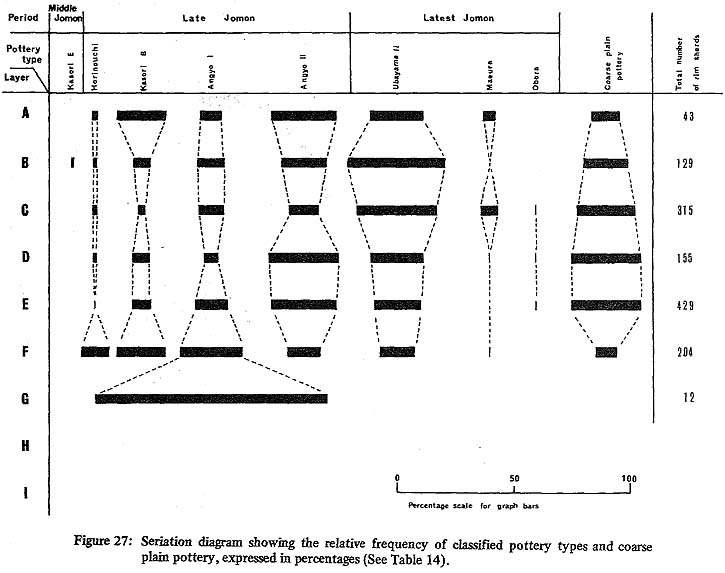
The pottery types in Figure 27 are arranged in known chronological order, the oldest on the left. All types are found in each layer except Layer G (and except the poorly represented Maeura and Obora types). This fact suggests either a slow accumulation of refuse in each layer during which several pottery types were used at the site or considerable accidental mixture. The latter is a great possibility in Layer A and B. The kind of quantity distribution demonstrated here illustrates one problem encoutered in stratigraphic excavations.
2) Analysis of the Vessel Shapes of the Classified Pottery Types
Definitive information on the classified pottery types may be expected to come from the analysis of the vessel shapes constituting each pottery type. Figure 28 (see also: Table 15) presents the relative frequency of each pottery type as sub-classified by vessel shape. An examination of this data shows that for all types (except Kasori E and Obora for which insufficient data exist) the Jar with Flat Rim form is most common.
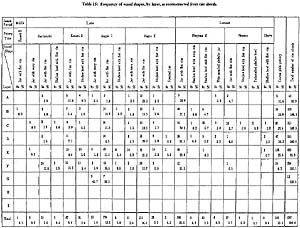
Table 15: Frequency of vessel shapes, by layer, as reconstructed from rim sherds. |
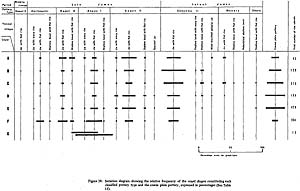
Figure 28: Seriation diagram showing the relative frequency of the vessel shapes constituting each classified pottery type and the coarse plain pottery, expressed in percentages (See Table 15). |
As already described, each vessel shape has several varieties (denoted A, B, etc.) based on the decoration techniques and patterns. Figure 29 (see also: Table 16) gives the relative frequency of each variety of vessel shape grouped according to pottery type. This data shows that the Ubayama II Jar with Flat Rim variety A and the coarse plain pottery have the highest percentages of any variety in all layers except F and G.

Table 16: Frequency of vessel shapes, by layer, as subclassified by decoration techniques and pattern. |
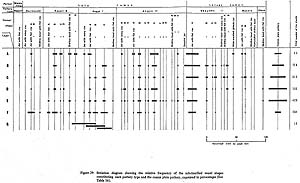
Figure 29: Seriation diagram showing the relative frequency of the subclassified vessel shapes constituting each pottery type and the coarse plain pottery, expressed in percentages (See Table 16). |
|